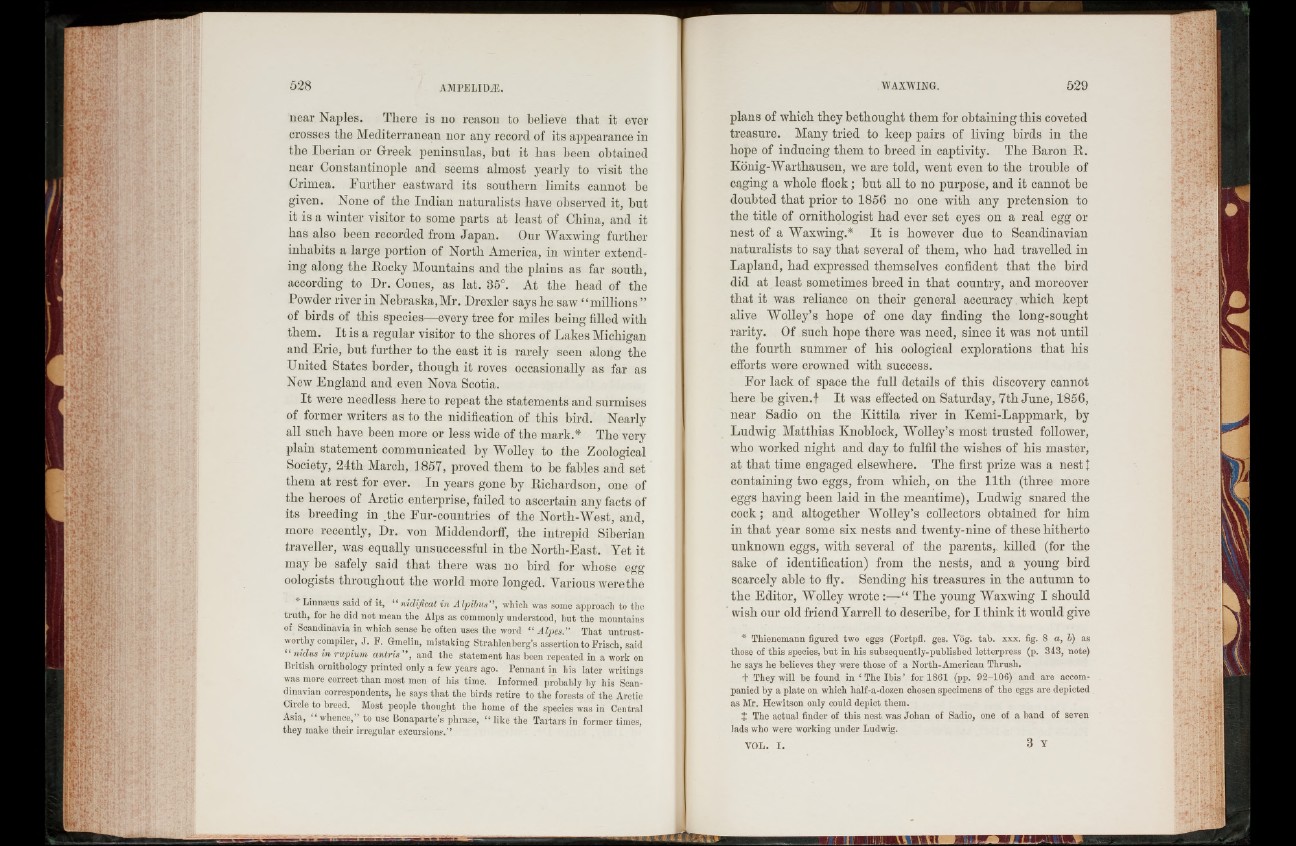
near Naples. There is no reason to believe that it ever
crosses the Mediterranean nor any record of its appearance in
the Iberian or Greek peninsulas, but it has been obtained
near Constantinople and seems almost yearly to visit the
Crimea. Further eastward its southern limits cannot he
given. None of the Indian naturalists have observed it, but
it is a winter visitor to some parts at least of China, and it
has also been recorded from Japan. Our Waxwing further
inhabits a large portion of North America, in winter extending
along the Rocky Mountains and the plains as far south,
according to Dr. Coues, as lat. 35°. At the head of the
Powder river in Nebraska,Mr. Drexler says he saw “ millions ”
of birds of this species—every tree for miles being filled with
them. I t is a regular visitor to the shores of Lakes Michigan
and Erie, but further to the east it is rarely seen along the
United States border, though it roves occasionally as far as
New England and even Nova Scotia.
I t were needless here to repeat the statements and surmises
of former writers as to the nidification of this bird. Nearly
all such have been more or less wide of the mark.* The very
plain statement communicated by Wollev to the Zoological
Society, 24th March, 1857, proved them to be fables and set
them at rest for ever. In years gone by Richardson, one of
the heroes of Arctic enterprise, failed to ascertain any facts of
its breeding in the Fur-countries of the North-West, and,
more recently, Dr. von Middendorff, the intrepid Siberian
traveller, was equally unsuccessful in the North-East. Yet it
may be safely said that there was no bird for whose egg
oologists throughout the world more longed. Various were the
Linnajus said of it, “ nidifical in Alpibus”, which was some approach to the
truth, for he did not mean the Alps as commonly understood, hut the mountains
of Scandinavia in which sense he often uses the word “ Alpes.” That untrustworthy
compiler, J. F. Grmelin, mistaking Strahlenberg’s assertion to Frisch, said
“ nidus in rupium antris " , and the statement has been repeated in a work on
British ornithology printed only a few years ago. Pennant in his later writings
was more correct than most men of his time. Informed probably by his Scandinavian
correspondents, he says that the birds retire to the forests of the Arctic
Circle to breed. Most people thought the home of the species was in Central
Asia, “ whence,” to use Bonaparte’s phrase, “ like the Tartars in former times,
they make their irregular excursions.”
plans of which they bethought them for obtaining this coveted
treasure. Many tried to keep pairs of living birds in the
hope of inducing them to breed in captivity. The Baron R.
König-Warthausen, we are told, went even to the trouble of
caging a whole flock; but all to no purpose, and it cannot he
doubted that prior to 1856 no one with any pretension to
the title of ornithologist had ever set eyes on a real egg or
nest of a Waxwing.* I t is however due to Scandinavian
naturalists to say that several of them, who had travelled in
Lapland, had expressed themselves confident that the bird
did at least sometimes breed in that country, and moreover
that it was reliance on their general accuracy which kept
alive Wolley’s hope of one day finding the long-sought
rarity. Of such hope there was need, since it was not until
the fourth summer of his oological explorations that his
efforts were crowned with success.
For lack of space the full details of this discovery cannot
here be given.t I t was effected on Saturday, 7th June, 1856,
near Sadio on the Kittila river in Kemi-Lappmark, by
Ludwig Matthias Knoblock, Wolley’s most trusted follower,
who worked night and day to fulfil the wishes of his master,
at that time engaged elsewhere. The first prize was a nest I
containing two eggs, from which, on the 11th (three more
eggs having been laid in the meantime), Ludwig snared the
cock; and altogether Wolley’s collectors obtained for him
in that year some six nests and twenty-nine of these hitherto
unknown eggs, with several of the parents, killed (for the
sake of identification) from the nests, and a young bird
scarcely able to fly. Sending his treasures in the autumn to
the Editor, Wolley wrote The young Waxwing I should
wish our old friend Yarrell to describe, for I think it would give
* Thienemann figured two eggs (Fortpfl. ges. Yög. tab. xxx. fig. 8 a, b) as
those of this species, but in his subsequently-published letterpress (p. 343, note)
he says he believes they were those of a North-American Thrush.
t They will be found in ‘ The Ib is ’ for 1861 (pp. 92-106) and are accompanied
by a plate on which half-a-dozen chosen specimens of the eggs are depicted
as Mr. Hewitson only could depict them.
J The actual finder of this nest was Johan of Sadio, one of a band of seven
lads who were working under Ludwig.
v o l . i . B y
h i— \ « m mmw m .